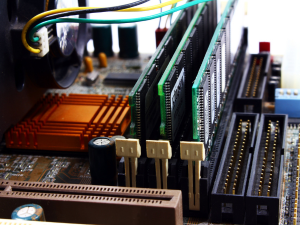 How can a solid network infrastructure benefit your small business? Beyond boosting productivity and offering a reliable data storage solution, it enhances connectivity and communication. This is crucial for fostering a unified team that can efficiently tackle necessary tasks and meet deadlines.
How can a solid network infrastructure benefit your small business? Beyond boosting productivity and offering a reliable data storage solution, it enhances connectivity and communication. This is crucial for fostering a unified team that can efficiently tackle necessary tasks and meet deadlines.
Understanding Network Infrastructure
The concept of network infrastructure is straightforward—it's all about connecting various devices within your business through a combination of hardware, software, cables, and network signals.
The "anatomy" of your network infrastructure includes key components such as:
- Routers, which link your network to the wider internet and facilitate local device connections.
- Network switches, enabling communication between devices and reducing congestion for improved connectivity.
- Networking protocols, which are the rules governing data exchange between devices.
- Network management systems, organizing the network components to enhance efficiency and speed.
Additionally, firewalls play a crucial role in safeguarding your network from cyber threats and data breaches.
Benefits of a Strong Network Infrastructure for Small Businesses
A robust and secure network infrastructure is foundational for reliable communication and digital transactions, offering:
Enhanced Connectivity
Network downtime can seriously hinder your team's productivity. Minimizing connection delays can significantly reduce lost work hours.
Data Security
In an era where digital operations are norm, securing sensitive information against cyber threats is vital to maintain trust in your brand.
Reduced Costs
Although improving your network infrastructure requires an initial investment, the reduction in downtime and increased efficiency can lead to significant savings over time.
Improving Your Small Business's Network Infrastructure
Enhancing your network doesn't have to be prohibitively expensive. Before considering major upgrades, cybersecurity professionals suggest starting with:
Backup Systems
Utilizing older cables and power supplies can provide a reliable backup to prevent network outages during power failures, ensuring work continuity.
IP VPNs
Implementing IP VPNs can secure department-specific data, preventing unauthorized access and enhancing internal security.
Advanced Security Measures
Adopting technologies like firewalls, zero-trust models, and detection software is essential for protecting against external threats.
Network Management Tools
Opt for network management solutions that are compatible with various infrastructures to streamline maintenance and avoid complications.
Building a Resilient Business Through Better Infrastructure
Your network infrastructure should grow and adapt to your business and its users' needs. From implementing backup and recovery systems to upgrading security measures, every step taken towards a more robust infrastructure strengthens your business's foundation. Integrated Technology Systems is here to assist your team to implement solutions that work for you.
Guard Against These Common Hardware Security Risks
 While the focus of cybersecurity often leans towards software threats like malware, email scams, and network breaches, the rise of the Internet of Things (IoT) has broadened the attack landscape significantly. Many overlook that hardware, just as much as software, can be a gateway for cyber threats. Indeed, traditional defenses like firewalls and antivirus programs are less effective against these types of attacks, making it crucial for businesses to also shore up their hardware defenses.
While the focus of cybersecurity often leans towards software threats like malware, email scams, and network breaches, the rise of the Internet of Things (IoT) has broadened the attack landscape significantly. Many overlook that hardware, just as much as software, can be a gateway for cyber threats. Indeed, traditional defenses like firewalls and antivirus programs are less effective against these types of attacks, making it crucial for businesses to also shore up their hardware defenses.
Here are some prevalent hardware security risks to be aware of.
Compromised Hardware
A straightforward yet potent method employed by attackers involves directly tampering with hardware on-site. This could range from altering connections on a desktop to swapping out server components. Such tampering can be challenging to detect but often results in successful breaches.
To mitigate these risks, regularly inspect hardware for any signs of unauthorized intervention — such as loose components, tampering marks, or exposed internals — and isolate any compromised equipment for further examination.
Default Factory Settings
IoT devices often come with factory-set default passwords, a security oversight that can be easily exploited. Despite manufacturers' expectations for users to update these credentials, many fail to do so, leaving a gaping hole in their network security.
To counter this vulnerability, ensure all device passwords are changed from their default settings before network integration.
Outdated Firmware
Hardware vulnerabilities can also stem from outdated firmware, filled with exploitable flaws and bugs. While manufacturers release patches to address these issues, the pace at which businesses apply these updates often lags.
Maintaining the security of your hardware involves regularly updating the firmware of all devices to patch known vulnerabilities promptly.
Custom Chipsets Vulnerabilities
In high-performance computing and data centers, custom chipsets are a necessity. However, these components can introduce security vulnerabilities, given that their security isn't always thoroughly vetted by manufacturers until after an exploit is discovered.
Before integrating custom chipsets into your network, evaluate the manufacturer's commitment to security and ensure they provide regular updates to protect against emerging threats.
In essence, safeguarding your business's digital infrastructure requires a dual focus on both software and hardware security. By being proactive in addressing hardware vulnerabilities, businesses can fortify their defenses against a wider range of cyber threats.
Keeping up with an everchanging cyber threat can be daunting. This is where Integrated Technology Systems can help. We will do a thorough analysis of your network and security policies and create a plan. Give us a call today.
Integrated Technology Systems
6 East 45th Street, Suite 400
New York, NY 10017
212-750-5420
https://www.itsnyc.com



